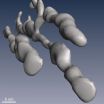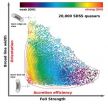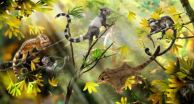(Press-News.org) The effect of movies featuring dogs on the popularity of dog breeds can last up to ten years and is correlated with the general success of the movies, according to new research from the University of Bristol, the City University of New York, and Western Carolina University.
The study, published today in PLOS ONE, also found that movies' influence was strongest in the early twentieth century and has declined since.
The researchers used data from the American Kennel Club, which maintains the world's largest dog registry totalling over 65 million dogs, and analysed a total of 87 movies featuring dogs. They found that the release of movies is often associated to an increase in popularity of featured breeds over periods of one, two, five, and ten years.
Additionally, they found that these trend changes correlated significantly with the number of viewers during the movie's opening weekend, considered as a proxy of the movie's reach among the general public.
This suggests that viewing a movie may cause a long-lasting preference for a breed that can be expressed years later, when the time comes to buy a new dog.
The impact of movies has been large. The ten movies with the strongest ten years effect were associated, the authors found, with changes in registration trends such that over 800,000 more dogs were registered in the ten years after movie release than would have been expected from pre-release trend.
The 1943 hit Lassie Come Home is associated, in the following two years, with a 40 per cent increase of Collie registrations in the American Kennel Club. An even more dramatic example is the 100-fold increase in Old English Sheepdog registrations following the 1959 Disney movie The Shaggy Dog.
Professor Stefano Ghirlanda, lead author of the study said: "We focused on changes in trend popularity rather than on popularity itself to avoid attributing to movies trends that were already ongoing before movie release, as up-trending breeds may have been chosen more often for movies."
The team also discovered a general decrease during the century of movies' influence on the success of dog breeds. Earlier movies are associated with generally larger trend changes than later movies. This might be due to an increased competition with other media, such as television, and more recently, the internet, but also to an increased competition among movies. Movies featuring dogs were released at a rate of less than one per year until about 1940 but a rate of more than seven per year by 2005.
The authors had previously shown how dynamics in dog breed popularity are subject to the erratic fluctuations typical of fashion and fads. For example, they discovered that the more rapidly puppy registrations increased, the more rapidly their popularity declined, a phenomena also found for baby names popularity.
Additionally, they showed that popularity of breeds is unrelated to breed temperament and health. Hal Herzog, co-author of the paper said: "On the whole, breeds with more desirable behaviours, greater longevity, and fewer inherited genetic disorders did not become more popular than other breeds. In short, cultural shifts in types of pets largely reflect ephemeral changes in fashion rather than selection for functional traits."
Cultural dynamics are often considered too whimsical to be subject of scientific enquiry but, the authors argue, studies like this demonstrate that influences on popular culture can be detected and quantified, given the right data.
But what are the consequences for the dogs? Dr Alberto Acerbi, a Newton Fellow in the Department of Archaeology and Anthropology at the University of Bristol and co-author of the paper said: "If people buy en masse dogs because they appear in movies the consequences can be negative for the dogs themselves. Our previous study found that the most popular breeds had the greatest number of inherited disorders.
"It's not surprising that we tend to follow social cues and fashions, as this is a quite effective strategy in many situations. However, in particular cases the outcomes can be negative. When choosing a new pet, we may want to act differently."
INFORMATION: END
New study shows impact of movies on dog breed popularity
2014-09-10
ELSE PRESS RELEASES FROM THIS DATE:
New 3-D imaging techniques may improve understanding of biofuel plant material
2014-09-10
Comparison of 3D TEM imaging techniques reveals never-seen-before details of plant cell walls, according to a study published September 10, 2014 in the open-access journal PLOS ONE by Purbasha Sarkar from University of California, Berkeley and colleagues.
Cost-effective production of plant material for biofuel requires efficient breakdown of plant cell wall tissue to retrieve the complex sugars in the cell wall required for fermentation and production of biofuels. In-depth knowledge of plant cell wall composition is therefore essential for improving the fuel production ...
New study examines impact of violent media on the brain
2014-09-10
(NEW YORK – September 10, 2014) With the longstanding debate over whether violent movies cause real world violence as a backstop, a study published today in PLOS One found that each person's reaction to violent images depends on that individual's brain circuitry, and on how aggressive they were to begin with.
The study, which was led by researchers at the Icahn School of Medicine at Mount Sinai and the NIH Intramural Program, featured brain scans which revealed that both watching and not watching violent images caused different brain activity in people with different ...
Study ties groundwater to human evolution
2014-09-10
Our ancient ancestors' ability to move around and find new sources of groundwater during extremely dry periods in Africa millions of years ago may have been key to their survival and the evolution of the human species, a new study shows.
The research – published in the journal PLOS ONE – combines geological evidence from the Olduvai sedimentary basin in Northern Tanzania, which formed about 2.2 million years ago, and results from a hydrological model.
It shows that while water in rivers and lakes would have disappeared as the climate changed due to variations in the ...
Is spooning really the best position for men with back pain?
2014-09-10
September 10, 2014 – A study using motion capture technology provides new information on the spinal strain produced by various sexual positions—suggesting that one position commonly recommended for all men with low back pain is not actually the best choice, reports a study in the journal Spine. The journal is published by Lippincott Williams & Wilkins, a part of Wolters Kluwer Health.
The results provide a more scientific basis for making individualized recommendations regarding sexual positions for men with low back pain, according to Natalie Sidorkewicz, MSc, and Stuart ...
Seismic gap may be filled by an earthquake near Istanbul
2014-09-10
When a segment of a major fault line goes quiet, it can mean one of two things: The "seismic gap" may simply be inactive — the result of two tectonic plates placidly gliding past each other — or the segment may be a source of potential earthquakes, quietly building tension over decades until an inevitable seismic release.
Researchers from MIT and Turkey have found evidence for both types of behavior on different segments of the North Anatolian Fault — one of the most energetic earthquake zones in the world. The fault, similar in scale to California's San Andreas Fault, ...
Gibbon genome sequence deepens understanding of primates rapid chromosomal rearrangements
2014-09-10
HOUSTON – (Sep. 10. 2014) – With the completion of the sequencing and analysis of the gibbon genome, scientists now know more about why this small ape has a rapid rate of chromosomal rearrangements, providing information that broadens understanding of chromosomal biology.
Chromosomes, essentially the packaging that encases the genetic information stored in the DNA sequence, are fundamental to cellular function and the transmission of genetic information from one generation to the next. Chromosome structure and function is also intimately related to human genetic diseases, ...
Mysterious quasar sequence explained
2014-09-10
Pasadena, CA—Quasars are supermassive black holes that live at the center of distant massive galaxies. They shine as the most luminous beacons in the sky across the entire electromagnetic spectrum by rapidly accreting matter into their gravitationally inescapable centers. New work from Carnegie's Hubble Fellow Yue Shen and Luis Ho of the Kavli Institute for Astronomy and Astrophysics (KIAA) at Peking University solves a quasar mystery that astronomers have been puzzling over for 20 years. Their work, published in the September 11 issue of Nature, shows that most observed ...
Researchers discover 3 extinct squirrel-like species
2014-09-10
Paleontologists have described three new small squirrel-like species that place a poorly understood Mesozoic group of animals firmly in the mammal family tree. The study, led by scientists at the American Museum of Natural History and the Chinese Academy of Sciences, supports the idea that mammals—an extremely diverse group that includes egg-laying monotremes such as the platypus, marsupials such as the opossum, and placentals like humans and whales—originated at least 208 million years ago in the late Triassic, much earlier than some previous research suggests. The study ...
Fish and fatty acid consumption associated with lower risk of hearing loss in women
2014-09-10
BOSTON, MA – Researchers at Brigham and Women's Hospital found that consumption of two or more servings of fish per week was associated with a lower risk of hearing loss in women. Findings of the new study Fish and Fatty Acid Consumption and Hearing Loss study led by Sharon G. Curhan, MD, BWH Channing Division of Network Medicine, are published online on September 10 in the American Journal of Clinical Nutrition (AJCN).
"Acquired hearing loss is a highly prevalent and often disabling chronic health condition," stated Curhan, corresponding author. "Although a decline ...
Research identifies drivers of rich bird biodiversity in Neotropics
2014-09-10
An international team of researchers is challenging a commonly held view that explains how so many species of birds came to inhabit the Neotropics, an area rich in rain forest that extends from Mexico to the southernmost tip of South America. The new research, published today in the journal Nature, suggests that tropical bird speciation is not directly linked to geological and climate changes, as traditionally thought, but is driven by movements of birds across physical barriers such as mountains and rivers that occur long after those landscapes' geological origins.
"The ...


